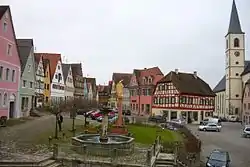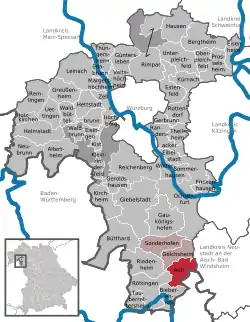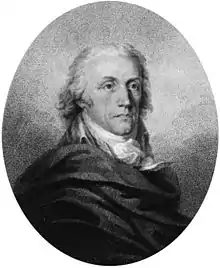Aub
Aub (German: [aʊp] (![]() listen)) is a town in the district of Würzburg, in Bavaria, Germany. It is situated 29 kilometres (18 mi) southeast of Würzburg, and 21 kilometres (13 mi) northwest of Rothenburg ob der Tauber.
listen)) is a town in the district of Würzburg, in Bavaria, Germany. It is situated 29 kilometres (18 mi) southeast of Würzburg, and 21 kilometres (13 mi) northwest of Rothenburg ob der Tauber.
Aub | |
|---|---|
 Market square in Aub | |
 Coat of arms | |
Location of Aub within Würzburg district  | |
 Aub  Aub | |
| Coordinates: 49°32′N 10°03′E | |
| Country | Germany |
| State | Bavaria |
| Admin. region | Unterfranken |
| District | Würzburg |
| Municipal assoc. | Aub |
| Subdivisions | 2 Stadtteile |
| Government | |
| • Mayor | Robert Melber (CSU) |
| Area | |
| • Total | 17.54 km2 (6.77 sq mi) |
| Elevation | 310 m (1,020 ft) |
| Population (2019-12-31)[1] | |
| • Total | 1,447 |
| • Density | 82/km2 (210/sq mi) |
| Time zone | UTC+01:00 (CET) |
| • Summer (DST) | UTC+02:00 (CEST) |
| Postal codes | 97239 |
| Dialling codes | 09335 |
| Vehicle registration | WÜ |
| Website | http://www.stadt-aub.de/ |
It is on the Gollach River, not far from the border of Baden-Württemberg. Aub is divided into three parts: Aub, Baldersheim, and Burgerroth.
History
The earlier territory of the Catholic Church in Würzburg became part of Bavaria when the government was secularized in 1805. The present municipality was created during the administrative reforms of 2010.
Population
The population has remained relatively stable since 1970, as shown in the following table:
| Population History | |
|---|---|
| Year | Population |
| 1970 | 1714 |
| 1987 | 1631 |
| 2000 | 1702 |
| 2005 | 1608 |
Administrative municipality
Aub forms an administrative municipality with the nearby towns of Gelchsheim and Sonderhofen.
Sister city
Landmarks
Aub has a beautiful church and a well-kept Jewish cemetery. The main church has a very fine carved wooden altarpiece by Tilman Riemenschneider, who was an important master sculptor in Southern Germany in the late Middle Ages. The town has most of its medieval walls intact, and an interesting small museum in the 'spittalkirche', a medieval monastery-cum-hospice, which served pilgrims and the old and infirm. Today the museum has objects from Aub's past, and displays about caring for the elderly through the centuries (all in German). Aub is the second smallest town in Bavaria. It has a bank, two bakery-cum-cafes, a doctor and a hairdresser. The countryside is very pleasant to cycle around. There is a cycle track along the disused railway line that leads to the Tauber valley, which is quite picturesque. A few kilometres from Aub is the church called the 'Kunegonde Kapelle', named after an early medieval queen-saint. The key to the chapel can be obtained from the nearby village. The chapel is very atmospheric inside. In the wall of the old church yard a (reputedly) 1,000-year-old pollarded lime tree still stands. When the Catholic Church is celebrating a major festival, the townsfolk dress up in medieval costume, the town band plays, and there is a fair with dodgem cars and American Line dancing in the evening, or a medieval fair with jousting in the grounds of the hunting lodge at the top of the town.
Personality

- Max Aub (1903-1972), novelist and playwright, was not from Aub, but he is, as well as the rabbi Joseph Aub, a descendant of Abraham Meyer from Aub
- Johannes Böhm (1485-1533/1535), German humanist
- Johann Adam Schmidt (1759-1809), doctor of Ludwig van Beethoven[2]
- Kaspar Bausewein (1838-1903), singer at the Munich Court Opera
- Konrad Hoos (1892-1982), priest, ecclesiastic council study professor, honorary citizen of Baldersheim
References
- "Tabellenblatt "Daten 2", Statistischer Bericht A1200C 202041 Einwohnerzahlen der Gemeinden, Kreise und Regierungsbezirke". Bayerisches Landesamt für Statistik und Datenverarbeitung (in German). July 2020.
- Beethovens Ärzte, Übersicht in englischer Sprache
